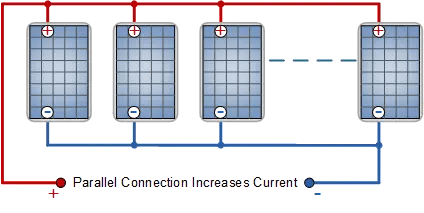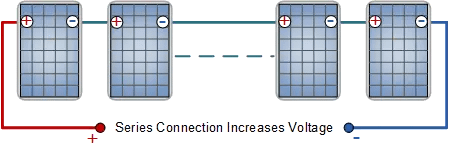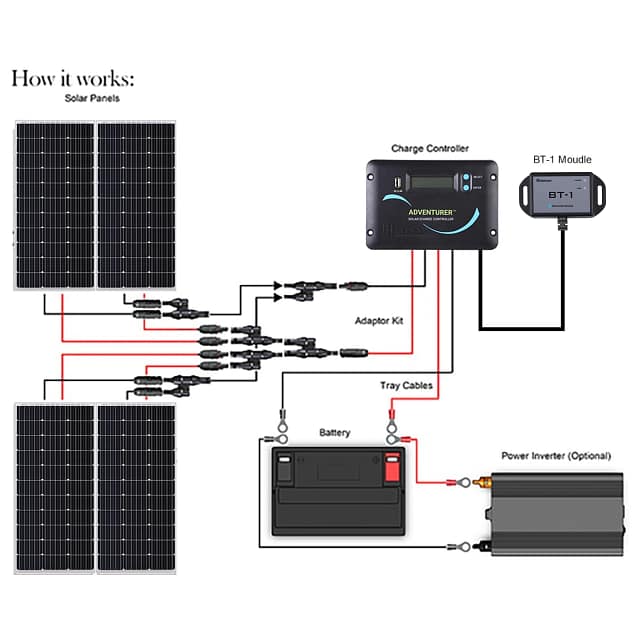Solar panels can be connected in series, parallel, or a combination of series and parallel. How do you know whether to connect your solar panels in series vs. parallel? There are pros and cons to both setups. Let’s take a look at what it means to connect in series and or in parallel. Then we will analyze a typical solar panel off-grid setup.
Parallel

PV panels connected in parallel have their positive wires connected together and their negative wires connected together
Parallel Connections Make More Current
When connected in parallel, the voltage of the system stays the same as the voltage of a single panel, and the current, or the amps, are added together to be twice the current of a single panel. Say the panels are nominal 20-volt, 5-amp panels, which is typical for a 100-watt panel. The parallel setup shown above gives 20 volts at 10 amps, which equals 200 watts.
Keep in mind that when the current increases, the required wiring size increase as well. Downstream of where two solar panels are connected, the current will be twice that of the current in the wiring of the single panel. Proper wire sizing is crucial to good system performance and also for safety. Parallel systems usually use more than one wire size. They also need special two-into-one connectors.
Proper Wire Size is Important
Don’t guess about wiring size. If you don’t know, either follow the manufacturer’s instructions or use a wire sizing tool. Make sure the wiring you use is rated for exterior use and recommended for solar power systems.
More Current Means Bigger Wires
Wiring is rated for current by size. 14 gauge wire is rated for a maximum of 15 amps and is typical for consumer-grade 100 amp panel connections. 14 gauge wire may be insufficient if the wire run is long. For a given current, the voltage drop increases with the length of the wire. To reduce the voltage drop, use a bigger wire. In the above example, note that it may be necessary to use a thicker wire where the two panels are connected together since the current is twice that for a single panel. Click here for an online wire sizing tool.
Series

To connect solar panels in series, connect the red wire of one solar panel to the black wire of the next panel. In a series connection, the system voltage is the sum of the individual panel voltages, while the system current (amps) is the same as that of an individual panel.
Series Connections Make Higher Voltage
Using the example of a 20-volt, 5-amp panel, the output of this series setup is 40 volts and 5 amps which equals 200 watts. In a series setup, the current remains the same no matter how many panels are connected.
Therefore, connecting four solar panels in series requires only one wire size. The limiting factor is voltage. Many charge controllers are designed to work with 100 or 150 as the maximum voltage. Higher voltages are also more dangerous.
More on Solar Panel Voltage
Speaking of voltage, you may have questions about why the example solar panel has a nominal rating of 20 volts. How does that work with 12, 24, and 48-volt systems? The answer has to do with how charge controllers and batteries work.
To start, charge controllers work best when the PV array voltage is higher than the battery charging voltage. Further, charge controllers have a maximum PV voltage rating, usually at least 100 volts.
12-Volt Batteries Charge Above 12 Volts
Also, consider that batteries charge at a higher voltage than their named voltage. For example, a 12-volt lead/acid battery charges between 14.7 and 13.2 volts, depending on whether it is deeply discharged or is on maintenance or float charge. Charge profiles vary depending on battery type, and good controllers auto-sense battery type or allow custom charge programming. For more on battery types and charging profiles, click here.
With the above factors in mind, a 20-volt solar panel, or a few 20-volt panels connected in parallel, are appropriate for charging a 12-volt battery. Two 20-volt panels in series give 40 volts which is good for charging 24-volt batteries.
Typical 400-watt Off-Grid System
Now that we have gone over the difference between series and parallel connections, let’s look at a typical setup for a 400-watt solar power system.
Below is a picture of a Renogy 400w off-grid solar energy system. Can you tell if the panels are connected in series or parallel? Here are three things to check: Does one solar panel’s black wire connect to the black wire of another panel? Do you see two-into-one wire connectors? Are the wires going to the charge controller thicker than the wires connected directly to the individual solar panels? In real life or in system specs, you would be able to see the different wire sizes.
If the answer is yes, that means you have a parallel connection. The answer is yes; the 4 100-watt solar panels are connected in parallel.
Why Did the Designers Choose Parallel vs Series?
To analyze this system, first recall that in a parallel system, the voltage remains the same, and the current is the sum of all the individual panel currents. These panels run at about 20 volts and up to about 5 amps, depending on the sunshine strength. That means the group of panels, also called the array, gives a total maximum output of about 20 volts at 20 amps.
Remember that the panel array voltage should be above the battery voltage for the best charging. So, this setup is great for a 12-volt battery system but too low for a 24-volt system.
For this 12-volt parallel system, what size charge controller do we need? On the solar panel side, charge controllers are rated for PV input watts and voltage. This example system is 400 watts at 20 volts.
That means you need a controller rated at 400 watts and 20 volts. When designing a system, it is a good idea to include some extra capacity in the charge controller for safety. In this example, a 500-watt/100-volt controller would also be a good choice. Don’t size the controller smaller than the maximum output of your solar panels.

Conclusion
Solar power can give you independence, and it is good for the Earth. But always remember that electricity can be dangerous. If you are new to solar, it is a good idea to start out with a complete kit and build and install it without modifications.
If you are unsure about what you are doing, consult an expert, join a solar energy forum, or call tech support for the equipment you have.
Series vs. Parallel: Pros and Cons
Series pros: Comes up to voltage earlier and later in the day. Simple hookup, one wire size.
Series cons: One bad panel brings down the whole system. Partial shading of the PV array severely affects performance. System voltage can get dangerously high.
Parallel pros: The system continues to make power with one bad panel or with some panels shaded. Voltages are lower and safer.
Parallel cons: The system begins charging the battery later in the day and stops charging earlier in the evening. Wiring is more complicated and requires multiple wire sizes.
To work with solar power, you should understand the difference between series and parallel connections as part of your introduction to practical electrical work. Electricity is a potential fire and shock hazard. If you are going to DIY, start small, and be careful.
Renogy Makes Complete Solar Energy Kits
As great starter systems, Renogy offers 200-watt and 400-watt systems. You can also get a battery to match if you want.
